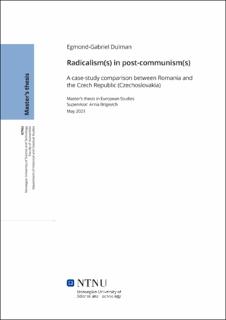| dc.contributor.advisor | Brigevich Anna | |
| dc.contributor.author | Dulman Egmond-Gabriel | |
| dc.date.accessioned | 2023-06-28T17:21:34Z | |
| dc.date.available | 2023-06-28T17:21:34Z | |
| dc.date.issued | 2023 | |
| dc.identifier | no.ntnu:inspera:144932901:89087642 | |
| dc.identifier.uri | https://hdl.handle.net/11250/3074179 | |
| dc.description.abstract | Hvorfor er den radikale venstresiden nesten ikke-eksisterende i Romania, etter kommunismens fall? Hvorfor er det alltid en gjenoppblomstring av de radikale høyremaktene? Partier som «Greater Romania» i fortiden, og «Alliance for Union of Romanians» nå, alle disse er merket eller proklamerer seg helt til høyre i det politiske spekteret. Hvorfor er det ingen attraksjon i det hele tatt for de radikale venstrebevegelsene, i Romania? Samtidig, hvorfor et annet postkommunistisk land, som Tsjekkia, har bevart et ganske vellykket radikalt venstreparti hele veien i overgangsperioden? «Kommunistpartiet i Böhmen og Mähren (CPBM)» har eksistert ganske lenge, selv med det "beryktede" ordet i tittelen. Det er selvfølgelig vanskelig å finne en klar og unik årsak til hvorfor dette har skjedd, så i denne oppgaven har vi forsøkt å foreslå en rekke forklaringer som i det minste delvis kan avklare de ulike behovene til to land som har delt en felles skjebne under kommunismen, og til og med under postkommunismen. Vi vil gjerne huske at listen over hendelser ikke er uttømmende, da det kan være mange andre viktige øyeblikk som kunne ha formet et lands tilbøyelighet til mer høyre eller mer venstre.
Gjennom hele studien har vi også sett på valgresultatene i den postkommunistiske perioden i Tsjekkia og i Romania, for å få et inntrykk av hvordan de utvalgte radikale maktene presterte og hva som gjorde disse attraktive for andeler av velgerne.
Å se på ulike radikalisme er også nyttig for å forstå de generelle tendensene på samfunnsnivå, med ulike makter som utfordrer og til og med bestrider de tradisjonelle mainstream-partiene, som noen ganger selv får skylden for den folkelige misnøyen.
Forskningen har sett på historiske hendelser i begge land, som den kalde krigen, våren i Praha, jordskjelvet i Romania, de antikommunistiske revolusjonene i 1989 og den fredelige skilsmissen mellom Tsjekkia og Slovakia. Studien har også skilt mellom radikale og ekstremistiske partier, og fremhevet at radikalisme kan være nyttig for å stille spørsmål ved etablerte regler og oppdatere dem til nyere realiteter, mens ekstremisme er en fare for det politiske systemet. | |
| dc.description.abstract | Why the radical left is almost non-existent in Romania, after the fall of Communism? Why there is always a resurgence of the radical right forces? Parties like “Greater Romania” in the past, and the “Alliance for the Union of Romanians” now, all these are tagged or proclaim themselves to the far right of the political spectrum. Why there is no attraction at all for the radical left movements, in Romania? At the same time, why another post-communist country, such as the Czech Republic, has preserved a pretty successful radical left party all the way during the transition times? The Communist Party of Bohemia and Moravia (CPBM) has been around for quite some time, even with the “infamous” word contained in the title. Of course, it is hard to find a clear and unique reason of why this has happened, so in this thesis, we have tried to propose a series of explanations that could, at least partially, clarify the different needs of two countries that have shared a common destiny during the Communism, and even during post-communism. We would like to remember that the list of events is not exhaustive, as there can be many other important moments that could have shaped a country’s inclination towards more right or more left.
Throughout the study, we have also looked at the election results in the post-communist period in the Czech Republic and in Romania, to get an idea of how the chosen radical forces performed and what made these attractive to shares of the electorate.
Looking at different radicalisms is also helpful in understanding the general tendencies at the societal level, with different forces challenging and even contesting the traditional, mainstream parties, that sometimes are themselves to be blamed for the popular discontent.
The research has looked into historical events in both countries, such as the aftermath of World War II, the Prague Spring, the earthquake in Romania, the anti-communist revolutions in 1989, and the peaceful divorce between the Czech Republic and Slovakia. The study has also differentiated between radical and extremist parties, highlighting that radicalism can be useful in questioning established rules and updating them to newer realities, while extremism is a danger to the political system. | |
| dc.language | eng | |
| dc.publisher | NTNU | |
| dc.title | Radicalism(s) in post-communism(s). A case-study comparison between Romania and the Czech Republic (Czechoslovakia). | |
| dc.type | Master thesis | |
